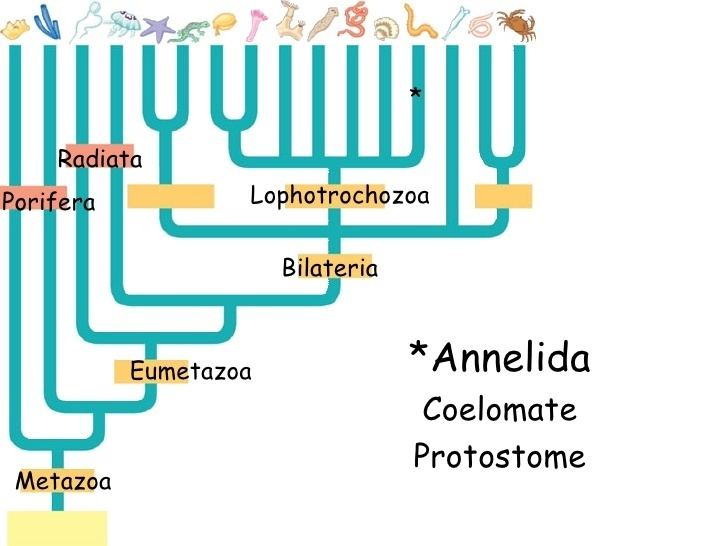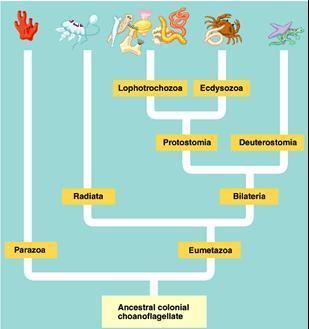Scientific name Eumetazoa Rank Subkingdom | Higher classification Animal | |
 | ||
Lower classifications Bilateria, Deuterostome, Vertebrate, Chordate, Arthropod | ||
Eumetazoa (Greek: εὖ [eu], well + μετά [metá], after + ζῷον [zóon], animal) is an clade comprising all major animal groups except sponges, Placozoa, and several other extinct or obscure life forms. Characteristics of eumetazoans include true tissues organized into germ layers, the presence of neurons, and an embryo that goes through a gastrula stage. The clade is usually held to contain at least Ctenophora, Cnidaria, and Bilateria. Whether mesozoans belong is in dispute. Ctenophora now appear basal eumetazoa, and Placozoa also appear to have emerged in eumetazoa. Eumetazoa would then be a basal Metazoan clade as sister of Porifera.
Contents

Some phylogenists have speculated the sponges and eumetazoans evolved separately from single-celled organisms, which would mean that the animal kingdom does not form a clade (a complete grouping of all organisms descended from a common ancestor). However, genetic studies and some morphological characteristics, like the common presence of choanocytes, support a common origin.

Eumetazoans are a major group of animals in the Five Kingdoms classification of Lynn Margulis and K. V. Schwartz, comprising the Radiata and Bilateria — all animals except the sponges, placozoans and mesozoans. When treated as a formal taxon Eumetazoa is typically ranked as a subkingdom. The name Metazoa has also been used to refer to this group, but more often refers to the Animalia as a whole. Many classification schemes do not include a subkingdom Eumetazoa.

Eumetazoa
Taxonomy

Over the last decade, the work of developmental biologists and molecular phylogeneticists spawned new ideas about bilaterian relationships resulting in a paradigm shift.

The current widely accepted hypothesis, based on molecular data (mostly 18S rRNA sequences), divides Bilateria into the following four superphylums: Deuterostomia, Ecdysozoa, Lophotrochozoa, and Platyzoa (sometimes included in Lophotrochozoa). The last three groups are also collectively known as Protostomia.
However, many skeptics emphasize the pitfalls and inconsistencies associated with the new data. Claus Nielsen, a professor of evolutionary invertebrate embryology at the Zoological Museum University of Copenhagen champions one of the most prominent alternative views based on morphological evidence. In his 2001 book Animal Evolution: Interrelationships of the Living Phyla, he maintains the traditional divisions of Protostomia and Deuterostomia.
Evolutionary origins
It has been suggested that one type of molecular clock and one approach to interpretation of the fossil record both place the evolutionary origins of eumetazoa in the Ediacaran. However, the earliest eumetazoans may not have left a clear impact on the fossil record and other interpretations of molecular clocks suggest the possibility of an earlier origin. The discoverers of Vernanimalcula describe it as the fossil of a bilateral triploblastic animal that appeared at the end of the Marinoan glaciation prior to the Ediacaran Period, implying an even earlier origin for eumetazoans.
